This post is by Igor Nusinovich, the CEO and co-founder of Valigara.
Now is an exciting time for jewelry sellers. Global sales are expected to grow by 5% to 6% each year, reaching a projected $250 billion by 2020. Consumer demand fell during the last recession, but it has since recovered and is now stronger than ever.
Demand has increased, but so has the level of competition. The wide variety of businesses who sell jewelry – including designers, retailers and manufacturers – now have to cast their net wider to find a receptive market and generate healthy sales.
In this guide I will take a broad look at the world of selling jewelry online. I’ll provide a primer on the main categories of jewelry that are sold, then look at the businesses that sell them and the latest buying trends.
I’ll cover the challenges faced when selling jewelry online, and the most important sales channels including Amazon, eBay, “alternative” online marketplaces, and independent webstores.
Jewelry categories
Jewelry spans a very wide range of price points and uses, from “fast fashion” pieces made from cheap materials and selling for a few dollars, through to the finest diamond jewelry selling for many thousands.
Each category is unique because buyers look at “hard” characteristics like design and price, but there are also many emotional factors in play when they buy. Here’s a quick roundup for those less familiar with the industry.
- Fashion jewelry: inexpensive items, often bought to complement a specific outfit. Made from alloys plated with precious metals, and crystal stones. This accessories are bought quickly, rarely as a gift, and with relatively low emotional involvement in the purchase process.
- Handcrafted jewelry: unique items created by individual jewelry artists and designers. Typically sold in independent boutiques and handcrafts marketplaces like Etsy. Buyers are interested in the materials used, which are often non-precious, as well as the crafting technique and the design itself.
- Fine jewelry: relatively expensive pieces, made from solid precious metals and precious gemstones. Sold by established jewelers, both in bricks-and-mortar stores and online. Fine jewelry can also be defined by the cost of raw materials, which typically make up 80% of the cost.
- Diamond jewelry: the most expensive category, but still highly in demand. Today, 18% of diamond jewelry is bought online. Traditionally family businesses, established brands, and companies with abundant capital reserves are the main players. The bridal market – mainly engagement rings – remains the largest segment of the diamond jewelry market.
- Niche categories: there are many other types of jewelry that do not fit naturally into the main categories above. These include vintage and estate jewelry, men’s jewelry, children’s jewelry and others. Some of these niches have strong demand and can be attractive growth areas for online sellers.
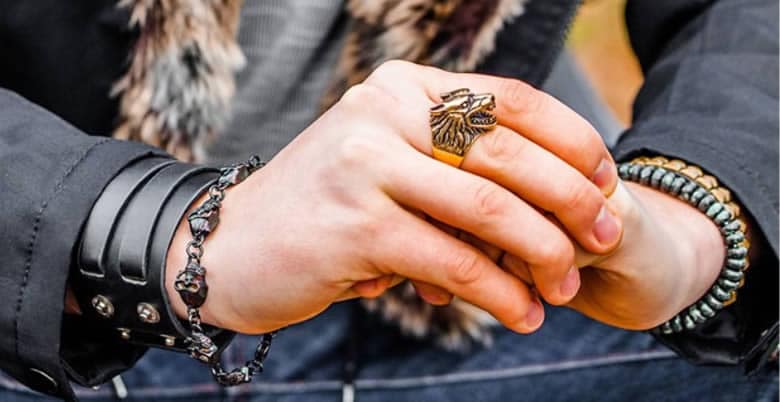
Who sells jewelry online?
The range of businesses who sell jewelry online is just as varied as the products sold, ranging from jewelry designers working alone to large manufacturers experimenting with direct-to-consumer selling.
- Handcrafted jewelry designers: these are highly-skilled people who are passionate about the art of designing and producing handmade jewelry. They typically sell their pieces through social media and ecommerce websites like eBay, Etsy, Amazon Handmade and smaller “targeted” marketplaces such as ArtFire and others. Due to production limitations, designers do not compete on price or by using technology automation. The main focus (and reason for existence) of these businesses are their unique designs, which are the driving force behind the community-based sites where they sell.
- Pure-play online retailers: businesses who specialize in selling jewelry products online. These “e-tailers” have directly entered ecommerce, without leveraging an existing bricks-and-mortar business. Some sell “no-name” jewelry by partnering with manufacturers or dropshippers, while more advanced players offer lines of their own design. By tracking online trends and understanding ecommerce technology, they produce their own “signature” product lines, in the fashion, fine or niche jewelry categories.
- Bricks-and-mortar retailers: we see these offline retailers being forced online to adapt to the changing needs of buyers. They have to completely update their marketing skills in order to succeed. These retailers are mostly small family jewelry businesses who select just one marketplace or other channel to sell their products online. Larger jewelry retailers with multiple stores are also online, and are more able to exploit ecommerce opportunities.
- Large manufacturers: expanding to direct online sales has been common for large players in the US and Europe for a long time. A relatively new trend in online retail is for Chinese factories to start selling directly to foreign consumers. We see this happening less in jewelry, as most manufacturers still prefer to operate as production partners to domestic retailers, due to high demands in logistics and customer service. But with success on domestic Chinese marketplaces such as Tmall, we may see them expand to Western marketplaces in the future.
Trends in buying jewelry online
Jewelry is usually an emotionally-driven purchase, and that makes buyer preferences and behavior hard to predict. Most people will take their time to select jewelry for important life-events, such as engagement and wedding rings. Other jewelry purchases, while still emotional, are made on impulse. And then again, a small number of people will buy jewelry as a long-term investment, without any emotional component.
In the case of fine jewelry and diamond jewelry, buyers often decide on the gems first and then select the setting in order to gauge how much they are willing to spend. For buyers and sellers alike, the price is important because the cost of the materials can be 70%-80% of the total product cost.
Jewelry is not just an ornament, it goes deeper than that. For buyers, their jewelry is strongly connected to their sense of self, and is a way to express who they are. The buyer’s personality, the occasion, the design, the price, and the sales channel all play a part in the experience of buying jewelry.
Here are the main trends we see in buying jewelry, and how they relate to online retail.
From “less is more” to “more for less”
Several years ago, it was common to think “less is more” when buying jewelry. Consumers were willing to buy a single piece of fine jewelry on just a few occasions in their lifetime, even if it cost them a pretty penny.
In the last twenty years, with improvements in production technology, we have seen a shift towards low-priced fashion jewelry, mass-produced in China, Thailand or India, allowing buyers to build a collection of jewelry for relatively little outlay. Essentially, the trend has become “more for less”, mirroring the explosion in cheap, almost disposable clothing that is often called “fast fashion”.
But the trend is varied in its effect. For the fashion jewelry category, it means that people can buy all the items in a given collection because the price is so affordable. For fine jewelry, much less has changed.
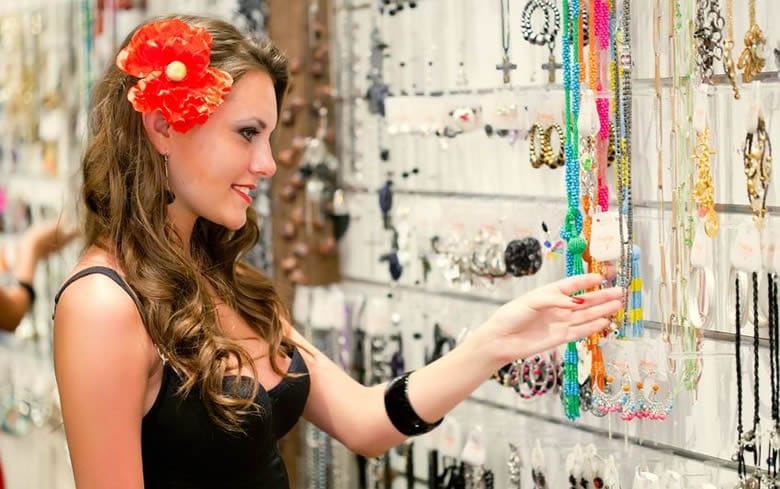
Fast mobile purchases
Mobile devices have made online jewelry purchases easier. Before the mobile age, either a special effort was needed to visit a jeweler, or some of the magic was lost by sitting down at a desktop computer. Now buyers can view product photographs and access information 24/7 – a good fit for the emotional and sometimes impulsive nature of buying jewelry.
Mobile devices allow buyers to search for a wide array of jewelry within a few clicks, so the overall buying process has become quicker and more convenient. High-DPI mobile screens are particularly well suited to viewing small, finely detailed products like jewelry. On the other hand, the switch to mobile can make in-depth research less comfortable.
Overall, we observe that the entire process of browsing, researching and selecting jewelry is twice as fast now as it was three years ago, when buyers had not really started to transact through mobile apps and websites.
Millennials
One interesting trend for a number of jewelry sellers is the behavior of Millennials – the generation born between the early 1980s and around 2000. There’s more than 80 million Millennials in the US alone, and they are the most tech-savvy group of consumers.
While many Millennials are at the age to buy diamond engagement rings, they are more likely to be interested in fashion jewelry and handcrafted jewelry. They are adventurous, quick decision makers, but less likely to take financial risks when buying luxury items such as fine jewelry. Millennials want to impress others through how they act and look, rather than the price of the products they buy.
As a very large generational group, Millennials present a lot of opportunities for online jewelry retailers, both now and as they age over the coming decades.
Male vs female buyers
While the “gender gap” has become much narrower in many respects over the last few decades, the typical jewelry-buying habits of men and women have remained quite different.
Often, men accompany their loved ones when they go shopping for fine jewelry and pay for the items that the women select. Men are mostly the ones who pay for engagement rings, wedding rings, and other gifts for such important occasions. The men responsible for these expensive purchases generally do not look for discounts, as that would devalue the whole experience.
For other types of jewelry (often items for lesser occasions) modern women do not wait for a man to buy something for them. An approximate guide is that a woman will buy jewelry for herself if its price is lower than the most expensive shoes she has ever bought!
There are also differences in the online channels that men and women typically buy from. Etsy, for example, mostly has female users: 67% of Etsy buyers and 86% of Etsy sellers are female. The overall Etsy experience and design is heavily tailored to a female audience.
The importance of reputation
Overall the reputation of individual sellers on online marketplaces has become less important in recent years, as the marketplaces have toughened up their performance standards and protection policies. We have seen this change less in jewelry, probably due to the cost and significance of jewelry purchases, along with the potential for hard-to-detect product authenticity issues.
Jewelry buyers do consider reputation, authenticity, and other people’s experiences when they shop. Even marketplaces with a reputation for selling cheap items, such as eBay, are important for retailers of the more expensive jewelry categories because buyers value the independent purchase protection policies that they provide.

For more expensive jewelry, we see very strong marketing connections across sales channels. Buyers will start their purchase on eBay, then check the seller’s website to see if the business is well-established and can be trusted. Buyers want to learn as much as they can about the seller before they buy an item. Even when they visit the retailer’s own website, the initial purchase is often completed on the marketplace to gain the protection that it provides. Seller’s should stay engaged with such buyers using social and email marketing to win repeat purchases – preferably on their own website.
Is selling jewelry online a good opportunity?
Jewelry was one of the earliest product categories to be sold successfully online. It certainly ticks a lot of the boxes for a product that can be sold profitably online: small size, low weight, high value, very visual and so on. Blue Nile, founded in 1999 and the largest online retailer of diamond jewelry, has annual sales of just under half a billion dollars.
When people buy jewelry, they buy an experience. There are many emotions involved when someone buys a piece of jewelry. While other expensive purchases (such as cars) depreciate in value, fine and diamond jewelry does the opposite. Jewelry is unique in its many positions as art, fashion, investment and an expression of personality, relationship and status. It offers many varied opportunities for online sellers.
Multi-channel online selling provides several strong advantages over the single brick-and-mortar store. In a traditional store, it can be hard to create a long-time connection which will establish trust. With online purchases, we often see five to eight rounds of communication between the seller and a potential customer before the purchase is completed. All this happens in the buyer’s “comfort zone”, not face-to-face with a salesperson in the store.
An additional advantage is the ability to show potential buyers how a gemstone, sapphire for example, can be transformed into hundreds of different designs. Using 3D modeling and rendering, it is easy to generate images and descriptions for all those designs without wasting the buyer’s time. The buyer controls the information that they want to see, without the need for physical items. Not only is your audience wider, but your content is also more accessible and dynamic.
Online selling provides data about listings and buyers that cannot be found in the offline world. Jewelry sellers can easily collect and analyze this data, then use it to fine-tune their selling strategies or even design their own product lines. New products can be designed completely virtually, and created only when an order is received.
Another advantage of selling online is that even an obscure niche can find an audience. For example, there’s a strong online market for “Nano Jewelry” – pieces containing crystals with microscopic inscriptions. In your local area, how many discerning buyers would there be for such a niche type of jewelry? Online, it’s possible to connect with thousands of passionate buyers around the world through marketplaces and social media.
Less esoteric jewelry, including handcrafted and fashion jewelry, men’s jewelry and children’s jewelry, also sells well online. All types of jewelry are emotional, visually-driven products. Selling online provides an opportunity to provide almost unlimited photographs, along with information on the design, manufacturing process and materials used. With creativity and business acumen, there are still many new opportunities that can be developed.
Challenges of selling jewelry online
In many ways jewelry looks like the perfect product to sell online – it’s small, valuable, easy to list and easy to send. But those positive factors are balanced by some significant challenges.
Non-standardized products
Selling jewelry differs a lot from selling laptops or smartphones. Commodity items have detailed specifications for each product model, and the buyer knows exactly what he is going to receive in the box. In contrast, for jewelry (even low-end fashion jewelry) each product is special. It takes an investment of time to list and describe items, with no existing catalog data to copy from. It is critical to add as many descriptive parameters about the piece as possible, to help buyers understand exactly what they are going to receive.
The uniqueness of each jewelry piece also means different products cannot be compared easily, so the usual repricing strategies will not work. In terms of design and production, if you commission a halo ring, for example, but later want to switch supplier, you shouldn’t expect another manufacturer to produce exactly the same design. Each one will be a little bit different, making all your product images obsolete.
High return rates
Jewelry has high return rates because decisions are so often driven by the buyer’s unique personality. If a piece of jewelry does not match a buyer’s favorite dress, for example, then there’s a probability that it will be returned.
For loose gemstones the situation is even more complicated. People will buy loose diamonds for their engagement or wedding rings, so they are bought more for their appearance than as an investment. When they take them to a jeweler to be set in a ring, they may find they do not suit the setting they would like to use, or the jeweler advises them to use a different stone. On eBay, loose diamonds have one of the highest return rates of all.
The expense of returns – both shipping and labor costs – should be considered when calculating prices and profit margins.
Production and materials
Precious metals and gemstones are expensive and scarce. Sellers of fine jewelry hold a relatively small stock of raw materials, and only create pieces when they are ordered. Lead times are long, which can cause problems with online shoppers and marketplaces expecting lightning-fast delivery.
Production is even more problematic for monogrammed and customized jewelry. A retailer cannot order shipments for every combination of the alphabet and put them into a fulfillment center. The value of surplus stock would be enormous. Customized jewelry is one of the top trends right now, but most businesses find fulfillment to be difficult.
Stocks of raw materials such as gemstones play an important role in the jewelry business due to their high value. To utilize their stock efficiently, many of our clients in the fine jewelry category have hundreds of virtual product variations made with the same gemstone. Without precise inventory control, tied to the raw materials, it’s easy to oversell if multiple products are ordered which require the same gemstone. The marketplaces penalize sellers for cancelled orders, so it’s important to monitor and update both product listings and the stock of materials.
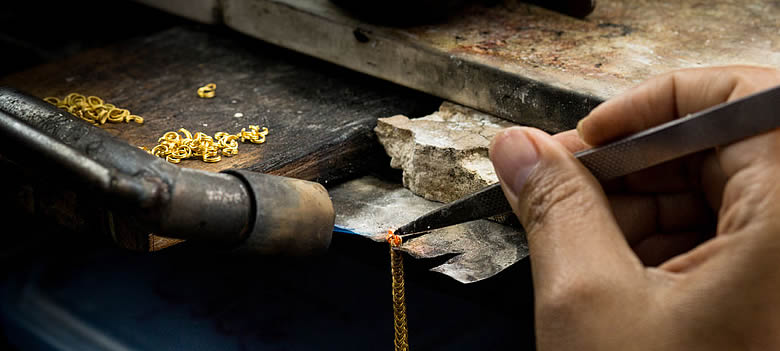
Seasonality
Jewelry is often bought as a gift for specific events. In the United States, Father’s Day in June is when a huge proportion of men’s jewelry is sold. If you sell jewelry for women, you have to prepare for Mother’s Day, Valentine’s and Christmas. There are very specific points of sale which dominate the calendar.
Jewelry sellers have to be aware of the right time to stock more items to prepare for higher demand. It also requires greater production and fulfillment capacity, so manpower must be increased in the sale seasons.
Shipping regulations
Precious metals and precious stones are highly regulated, particularly when shipping internationally. International carriers have specific regulations for jewelry. If you are in the US, we advise you to check with the USPS for their current instructions and regulations for the destination country. Some carriers need approval to send jewelry. DHL and FedEx ship jewelry internationally, but there are limits.
Precious metals and stones are highly valuable natural resources, and you cannot simply import and export diamonds by yourself. For instance, you need to use a registered importer to sell diamonds to France, or an importer of record to sell items over $2,500 to the US. Take a very close look at the specific regulations that apply to you and the countries you intend to trade with.
In some cases, you also need gemological certificates when you sell fine jewelry. These allow you and others to assess the selling price of your products, and can easily be traded across the globe.
A particular word of caution for diamond jewelry retailers: you could go to jail for not keeping records efficiently. Illegal import of natural resources is taken seriously by authorities. If a customer resells your diamond, you could be held liable if they don’t submit the record of origin promptly. Preventing this kind of scenario is why serious players have a local representative in their target countries. This allows local returns, which will later be forwarded to the manufacturer in the proper way. Shipping carriers who specialize in high-value shipments, such as Brinks, work hard to provide decent solutions to these issues.
Fraud
Fraud is a common problem with jewelry, particularly expensive items. An unscrupulous buyer could replace a $30,000 necklace with a cheap lookalike and then return the cheaper item in its place. Without a gemologist, sellers can find it really difficult to produce proof that the returned item was not their product. Some jewelry is difficult to authenticate, so documentary evidence should be followed up by the opinion of an expert.
Improper returns and return fraud plague online sellers, so they must create processes which minimize and discourage fraud.
Sizing
It’s not unusual for buyers not to know their ring size. Even for something as important (and expensive!) as an engagement ring, they will spend a lot of time picking out the band, diamond and setting, but get the wrong ring size for her finger.
When it comes to sizing it is worth the effort to make sure your buyer checks the size with a ring sizer. If you have a serious potential buyer, you can reduce the risk of a return by sending them a ring sizer (or selling it to them, then offering to take the cost of the sizer off the price of a ring). This simple step can drastically lower the probability of returned items due to incorrect sizing.
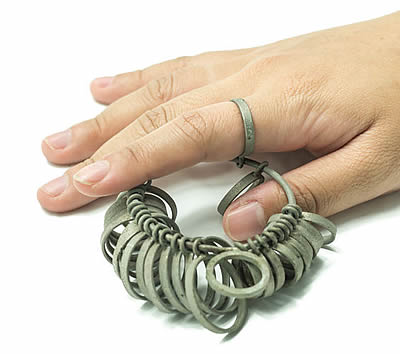
Long sales process
In fine jewelry, there is often a very long pre-sale process with customers to make sure that they understand completely what they are buying. Many businesses use online chat to communicate with customers. You need to be clear and professional in your communication with buyers. For example, sterling silver is 92.5% silver, but just “silver” means silver alloy.
You also need to act much like a professional jewelry salesperson in a bricks-and-mortar store. The role of the seller is to explain and advise buyers about all the details and options for the piece they are buying. For example, top grade white diamonds can be a waste if set on top of a yellow gold setting. The beautiful, crystal-clear (D color) diamond will look like the much cheaper yellowish (F color) alternative. You need to be knowledgeable and to explain ideas clearly to your customers.
Before an item is delivered, buyers don’t really know what they will get, so providing good close-up images of jewelry is very important. It’s especially important to show jewelry proportions and scale, so a picture on the body can be a good solution. You can capitalize on the fact that jewelry is a very visual product, so use creative product descriptions, pictures, and videos. There are DIY photography tips for jewelry in Web Retailer’s ecommerce photography guide.
Sales channels
Online marketplaces are important channels in almost every product category, including jewelry, because they build trust with buyers through customer feedback and product reviews. A sale is a sale, regardless of the channel it comes from, but in terms of marketing all sales channels are not equal. Large marketplaces like Amazon and eBay do help customers find you, but selling on them is not the final goal for most of the businesses we work with.
As I mentioned earlier, jewelry is a uniquely creative, individual and emotional product. For that reason, smaller marketplaces with a strong sense of community can often perform better to establish trust and credibility in you and your products than larger marketplaces.
eBay and Amazon
Of course, there are some jewelry sellers who do exceptionally well selling on eBay and Amazon.
We see a lot of Southeast Asian jewelry distributors selling mass-produced inexpensive fashion jewelry successfully on eBay, for example. Fashion jewelry is largely about price, and you can easily find the top-selling items on eBay being sold on sites like AliExpress and Alibaba. eBay has a fairly brief policy for selling jewelry through their marketplace, while Amazon’s policy is very detailed.
Following buyer complaints, Amazon do a very thorough job of ensuring that jewelry sellers follow their requirements – even making regular purchases themselves to check that sellers are in compliance. They won’t hesitate to issue warnings and even immediate suspensions for product quality violations. Because Amazon is much more regulated, we find that it can work well for more expensive jewelry items as well as cheap fashion jewelry.
Etsy
Etsy has a strong position as a leader for designers and retailers alike. For many jewelry retailers and artisans, their sales are higher on Etsy than on eBay and Amazon. The main difference between Etsy, eBay, and Amazon is that Etsy is much more community-based. It is also much more design and handcraft-oriented, and the seller community supports sellers through various interactions and activities.
Etsy’s platform is geared for human interaction instead of extensive use of bots and algorithms. On eBay around 90% of buyers reach item listings from the website search results, and only 10% come from eBay stores. But on Etsy, 40% of buyers reach items through store pages, or other items from the same seller. That’s one reason why taking part in the Etsy community is so important.
In October 2013, Etsy redefined their policy to allow sellers to use outside manufacturing. The change in Etsy’s policies made it more competitive, but also led to individual home-based sellers competing with larger businesses selling mass-produced items. One trend in production is to buy the base product from China and make some adjustments to create the final product. Most top Etsy sellers are not handmade producers now.
Amazon Handmade
Amazon Handmade, launched in October 2015, is a very interesting newcomer. It competes with Etsy but it is much more regulated: everything has to be handmade by small companies or collectives. While “handmade” has been expanded by Etsy to include mass-production in factories, Amazon Handmade is very firmly grassroots – they don’t even allow API access to manage listings in bulk.
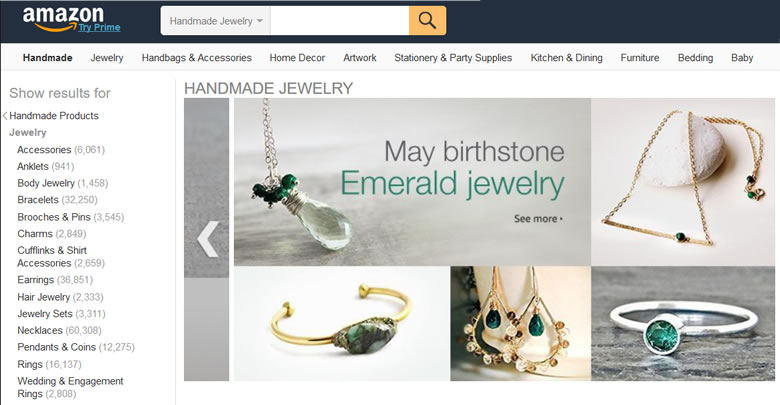
Amazon Handmade presents a big opportunity for sellers on Etsy and other crafts marketplaces. Amazon has massive buyer traffic and marketing capacity, and it is where you can find more expensive items. However, it’s still too early to tell if individual craftspeople are experiencing significant success in Amazon Handmade.
One interesting phenomenon since the launch of Amazon Handmade, is that it has caused Etsy to up their game!
Social networks
Facebook, Twitter, Pinterest and other networks have proven themselves to be an important ingredient in the online marketing and sales mix. For small jewelers, social networks can be a salvation and a real game-changer.
Staying engaged with your buying community creates a bridge between first and second purchases, empowers your brand, deals with seasonality, and is critical for long-term success. With that, social networks are not built to cover the process of purchase completely, and require knowledge to link them with a dedicated sales point – an external marketplace or your website.
We also see LinkedIn being a valuable network for our wholesale-oriented sellers.
Web stores
Marketplaces have relatively expensive fees, and don’t create the brand awareness that’s necessary to drive repeat sales. Sellers need them to win new customers, but they should not be their only sales channel.
Another weakness of marketplaces is that the sales process is the same for every category. To provide a personalized sales process such as an interactive custom-product builder, you have to create your own website. Not only does it establish your brand, but it also means that your competitors are not visible in the same place. You can drive prices higher because there’s no direct competition.
But we do not recommend using a website as your sole sales channel either. If you sell exclusively through a website, you will find it difficult and expensive to win new customers through search engine optimization or PPC advertising. Having more channels gives you more visibility.
My advice to sellers is a three-step marketing strategy which we call the “PPC killer”. First, win new customers using marketplaces like eBay, Amazon and Etsy. Second, engage with those buyers through social media and email marketing. Third, send them to standalone points of sale – such as your own web store.
Other marketplaces
For many product categories, “alternative” marketplaces do not generate sufficient sales to be worthwhile. But for jewelry, there are a number of lesser-known marketplaces that should be explored. These are based around artisan, craft or vintage products, often with a similar community-driven vibe to Etsy.

Jewelry sellers and designers should look into the potential of ArtFire, OpenSky and Ruby Lane. Each of these channels has its own niche and a strong following of its own. The homegrown community feel benefits jewelry sellers and small businesses.
We haven’t seen significant sales for jewelry sellers from more generalist alternative marketplaces such as Rakuten, Bonanza, Overstock, Jet.com, and Wish.com.
International
Shipping internationally can be a great idea, but there are also risks and limitations. As jewelry is small and light, international shipping can be quite cost effective, and there may be higher profit margins to be made in countries where similar products are more expensive or simply not available. But as I mentioned above, there can be strict shipping regulations and carrier limitations for the countries you want to ship to, particularly for expensive fine jewelry and diamond jewelry.
Once you have identified a major international market for your products, perhaps through shipping internationally at first, I highly recommend that you establish a local presence there. One good approach is to start a partnership with a certified jewelry importer. They can act as your local representative not only for importing, but also as a middleman to handle returns on your behalf. That way, when an international buyer returns an item, they will not need to send it all the way to your country. Instead, they can send it to your local representative, who will check that it is the correct item before forwarding it on to you.
In closing

In this post, I’ve covered the different categories of jewelry that are sold online, and the types of businesses who sell them. I’ve also talked about the ways in which consumers buy jewelry online, and how that has been changing.
Without doubt, jewelry ecommerce is fascinating and has great potential. Jewelry is one of the most established product categories in ecommerce, and the community of buyers is growing. We definitely will see further growth and new strong players joining the game.
Many of the challenges of selling jewelry are to do with the special nature of the products, and the different processes and limitations compared to other product categories. Sellers have to be aware of regulations and restrictions, as well as handling the logistical challenges that come with items that are often made-to-order and personalized.
There are several different marketplaces that are important for both small businesses and larger retailers selling jewelry online. It is important to utilize more than one sales channel, not just to have a wider reach but also to gain the trust of buyers and build your brand.
I hope that this post has encouraged and enlightened you. Stay open to new ideas, work smart and enjoy the game!
This post was by Igor Nusinovich, the CEO and co-founder of Valigara, with Andy Geldman and Delwin Rose Villarey.
Valigara provides a multi-channel marketing platform for selling jewelry, diamonds and gemstones online. Valigara also provides ecommerce outsourcing services to jewelry retailers, managing all their online marketing, sales and customer service.

Do you know of any websites where I can design and sell jewelry from using and ecommerce platform?